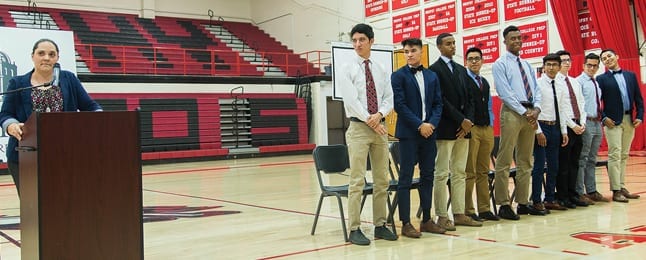By William Bole
In early February, a few dozen leaders of Jesuit secondary and pre-secondary schools converged in Arizona — where they posed for a picture that tells a tale of change and renewal in the Society of Jesus. In the not-too-distant past, the photo would have depicted an assemblage of men, likely sporting clerical collars; fewer than three decades ago, there wasn’t a single lay person, male or female, among the presidents and principals of schools in the California Province of Jesuits (although a few lay people held those positions in the Oregon Province). But in the photo taken earlier this year at Brophy College Preparatory in Phoenix, the presence of lay collaborators in Jesuit education was palpable — with more than a dozen women arrayed among them.
The principals and presidents had come together for a February 6-8 gathering under the banner of Companions in School Leadership, comprised of leaders from the 18 Jesuit secondary and pre-secondary schools in Jesuits West, which encompasses ten states in the former California and Oregon Provinces. These companions are playing no small part in fleshing out a pronouncement made at the 35th General Congregation of the Jesuits in Rome, which called attention to lay collaborators. “We must … look to our collaborators in mission and say, with gratitude and affection, that the call we have received is a call shared by us together,” the Congregation declared in 2006. On Brophy’s picturesque campus, a separate photo taken at the meeting offered a glimpse into the particular story — 13 women, clustered around a statute of Jesus, Mary and Joseph, touching each other and the Holy Family. They, plus another woman not present, have answered the shared call to serve as leaders of Jesuit middle and high schools from Alaska on down to Arizona.
Nationally, it was in the mid-to-late 1980s that lay people began surfacing in the ranks of Jesuit school principals, and lay presidents (whose overseeing role extends to fundraising, campus ministries, admissions and other non-academic activities) started appearing in the 1990s, according to Fr. Bill Muller, SJ, executive director of the Jesuit Schools Network. Based in Washington, D.C., the network has 81 member secondary and pre-secondary schools, mostly in the United States with several in Canada and a scattering elsewhere. Today, aside from the more numerous principals, there are eight women presidents of these schools across the U.S. Fully half are now serving in Jesuits West.
Although lay men are preponderant, women have arrived more recently to these posts, and their numbers are expanding. Many of these women have years of experience in Jesuit education and lay formation programs that are focused on Jesuit identity.
What follows are stories of three women — leading three different kinds of Jesuit schools.
Once the Jesuits Get You

Margaret Higgins at the Missioning Mass with Cristo Rey San José Jesuit High School students.
About a decade ago, Margaret Higgins read an article about an archdiocesan (non-Jesuit) school in San Francisco joining the Cristo Rey network. This is the network of Catholic high schools (numbering 35 nationwide) that integrates academic and professional work as part of a college preparatory program geared exclusively to students from low-income families. Higgins, who at the time was serving as the University of San Francisco’s vice president of student affairs, was deeply moved by this model of secondary education.
“I remember my heart stirring at the time,” Higgins says. She felt drawn to the idea of serving this population of students but she also had no desire to leave the Jesuit world that she was part of at USF. “I was at home in Jesuit education,” she recalls. “Once the Jesuits get you and break your heart, you’re done.”
In 2017, a recently established Cristo Rey school in San José was searching for a president. This time it was a Jesuit Cristo Rey school, and Higgins — then serving as development director at Santa Clara University, another Jesuit institution — took the leap. She became president in December of that year.
Cristo Rey San José Jesuit High School opened five years ago with 130 students from underserved communities and now enrolls more than 450. Students, male and female, work one day a week at a participating company, which not only helps finance the college prep education but also provides them with professional experience. “It’s a population that God has called us to serve,” says Higgins, referring to people doing this work in the context of the Jesuit mission. And the students are being served well: Last year, every single member of the inaugural graduating class enrolled in a college or university. All are first-generation college students.
Asked about her leadership role models, Higgins points to two women: her mother, a middle school secretary in New York who faithfully exhibited “ingenuity, creativity and unconditional love,” and the Blessed Mother, an unwed teenager who hesitated momentarily but joyously accepted God’s call to bear the child Jesus. “You talk about jumping in without a safety net!” she says of Mary. “I think as leaders, we have to deliberate and all that, but we also have to trust in God, and sometimes, we really just have to say ‘Yes’.”
I Fell in Love with the Mission

Erin Luby with Seattle Preparatory School students.
Having slowly nurtured an interest in Catholic education, Erin Luby dove in, headfirst, after graduating from Notre Dame: she taught for two years at a diocesan school in Phoenix through Notre Dame’s Alliance for Catholic Education program, and then for a year and a half in Santiago, Chile, at a Congregation of the Holy Cross school. But her full calling did not become apparent until she returned to her hometown, Chicago, and began teaching English at a Jesuit school, St. Ignatius College Prep.
“I didn’t realize how profoundly it” — Jesuit education — “would impact my life,” says Luby, who went on to serve in other roles at St. Ignatius including assistant principal for student services. “I fell in love with the mission.” The familiar phrases — “finding God in all things,” “men and women for others,” “cura personalis,” or care for the whole person — took on a deep and personal meaning for her. “That’s what grabbed me. It’s what gave me a sense of vocation and kept me in Jesuit education.”
After a while (Luby spent 12 years at St. Ignatius), friends began urging her to consider becoming a principal somewhere. “Then it was just a matter of time, trusting that this is what God wanted me to do,” she explains. At the time, she didn’t give deep thought to the reality that she was a woman aspiring to such a position in Jesuit secondary education. “My normal was really strong female leadership. That’s what I saw at St. Ignatius. That’s all I knew in Jesuit education,” Luby relates.
Ultimately, she trusted that Seattle Preparatory School was the place for her to continue pursuing her vocation — she assumed the role of principal in 2016. The idea of living roughly 2,000 miles from family and friends was daunting, but Luby says she felt at home when she arrived at Seattle Prep and encountered “a vibrant school culture with students who care deeply for each other” as well as teachers and staff who are “laser-focused on how to live our mission.” She feels grateful also that her journey took her from a school in Chicago that makes ample room for women leaders to a Jesuit Province that does the same, in its schools.
Among the new initiatives at Seattle Prep during Luby’s tenure is the Ignatian Leadership Conference, held for two days at the end of the school year. It’s designed to help juniors become discerning and transformational leaders guided by the example of St. Ignatius Loyola, visionary founder of the Society of Jesus.
There are many other plans and hopes for the 128-year-old high school, but what ties all of the initiatives together is the mission, as Luby sees it. “It’s a mission of helping to form whole persons, critical thinkers who are open to growth, spiritually alive and committed to justice,” she says. “That’s what grounds me.”
I Have 70 Boys

Kendra Krause with Loyola Academy students.
Kendra Krause has the distinction of being the first leader of a first-of-its-kind Jesuit school. She directs Loyola Academy, which opened in 2011 as the middle school at Brophy College Preparatory in Phoenix. The innovation is that it’s both a full-scholarship academy reserved exclusively for underserved boys — and part of a long-established Jesuit high school.
“Our goal is to take kids who wouldn’t go to Brophy, and make sure they do,” says Krause. Her 70 boys — they’re called “scholars” — receive a high-quality private education with an extended school day and, even more notably, an extended school year. They take summer trips to colleges in Arizona and California as well as to Washington, D.C., and to other destinations for both enrichment and fun. Nearly all of them do wind up attending Brophy, which enrolls 1,350 young men altogether.
In 2016, Jesuits West launched a second middle school on this model: Fr. Sauer, SJ, Academy at St. Ignatius College Preparatory in San Francisco. The notion is spreading. Recently, St. Ignatius High School in Cleveland announced that it too will be opening such an academy this coming August.
Krause also serves Brophy College Preparatory (the high school affiliated with Loyola Academy) as assistant principal for faculty development. Four years ago, she took the further initiative to launch a program to bolster awareness of sexual assault on college campuses. The idea is that each year, Brophy sends approximately 350 young men to those campuses. She wants Brophy’s future undergraduates to be the ones who speak up and intervene when a troubling incident is looming, so the school introduced an annual daylong training workshop called “Moral Courage: Taking a Stand Against Sexual Assault.” It’s mandatory for seniors.
Along with Higgins and Luby, Krause has well-founded hopes for her students. All three say they hope, most of all, for the students to grow spiritually, intellectually and socially as men and women for others.
“I have 70 boys in the middle school. They’re all hope personified. They’re young, smart, sweet and resilient, and they all have big dreams,” says Krause. (Then there’s the bracing ambition that Higgins has: “I would like to be the receptionist for the first Cristo Rey graduate who takes over Google or Apple.”)
For his part, Fr. Muller of the Jesuit Schools Network points to those like the 14 women presidents and principals in Jesuits West, who are helping to shape and reshape the Society of Jesus’ educational mission. “That gives me a hopeful sense for the future.”

Margaret Higgins, Kendra Krause and Erin Luby
Presidents and Principals
These are the 14 women serving as presidents and principals of Jesuits West schools:
Cindy Reopelle Principal, Gonzaga Preparatory School, Spokane.
Erin Luby Principal, Seattle Preparatory School, Seattle.
Cindy Davis Principal, Bellarmine Preparatory School, Tacoma.
Kristina Luscher Principal, Bellarmine College Preparatory, San Jose.
Adria Renke President, Brophy College Preparatory, Phoenix.
Kathy Schneider Interim President/Principal, Loyola Sacred Heart High School, Missoula.
Nancy Hanson President, Catholic Schools of Fairbanks.
Amanda Angaiak Principal, Immaculate Conception School; and President-elect, Catholic Schools of Fairbanks.
Margaret Higgins President, Cristo Rey San José Jesuit High School.
Brandi Odom-Lucas Principal, Verbum Dei High School, Los Angeles.
Carolyn Becic President, Saint Andrew Nativity School, Portland.
Lorraine Shepherd Principal, Sacred Heart Nativity Schools, San Jose.
Kendra Krause Director, Loyola Academy at Brophy College Preparatory, Phoenix.
Karen Hammen Director, Fr. Sauer, SJ, Academy at Saint Ignatius College Preparatory, San Francisco.
William Bole, whose articles have appeared in the Washington Post, Los Angeles Times and many other outlets, writes frequently on Jesuit topics.

